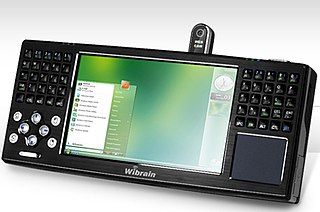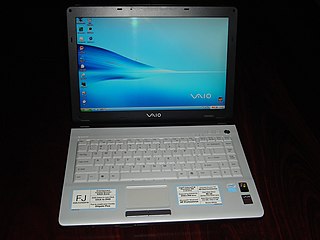Related Research Articles
VAIO Corporation is a Japanese manufacturer headquartered in Azumino, Nagano Prefecture that makes personal computers and smartphones.

An ultra-mobile PC is a miniature version of a pen computer, a class of laptop whose specifications were launched by Microsoft and Intel in spring 2006. Sony had already made a first attempt in this direction in 2004 with its Vaio U series, which was however only sold in Asia. UMPCs are generally smaller than subnotebooks, have a TFT display measuring (diagonally) about 12.7 to 17.8 cm, are operated like tablet PCs using a touchscreen or a stylus, and can also have a physical keyboard. There is no clear boundary between subnotebooks and ultra-mobile PCs, but UMPCs commonly have form factors other than the common clamshell laptop design, such as having small keys on either side of the screen, or having a slide-out keyboard.

The Qosmio series was Toshiba's consumer-marketed line of high performance desktop replacement laptops. The laptop was first released on July 25, 2004 as the E15-AV101 with a 1.7 GHz Intel Pentium M CPU, 512 megabytes of DDR SDRAM, and a 15-inch XGA 1,024 by 768 screen. Toshiba's most powerful laptop has undergone many revisions, with focus shifting from high-end multimedia functionality to heavy gaming. The current line, the X70 series, was released in 2013, featuring an Intel Core i7 processor with up to 32 gigabytes of DDR3 SDRAM and an nVidia Geforce GTX 770M as well as a 17.3 inch Full HD display.
The Vaio VGN-TX2 was a subnotebook, or ultraportable, computer made by Sony.

The Sony Vaio FJ series is a 14.1 inch notebook designed for Windows XP and the FJ270, FJ290, FJ330,FJ370 models in particular, are designed for Windows Vista. The FJ Series uses only the Pentium M processors using the Sonoma platform of Intel Centrino.

The MacBook Air is a line of laptop computers developed and manufactured by Apple Inc. It consists of a full-size keyboard, a machined aluminum case, and, in the more modern versions, a thin light structure. The Air was originally positioned above the previous MacBook line as a premium ultraportable. Since then, the original MacBook's discontinuation in 2011, and lowered prices on subsequent iterations, have made the Air Apple's entry-level laptop. In the current product line, the MacBook Air is situated below the performance range MacBook Pro.

HP TouchSmart is a series of tablet PC laptops and touchscreen all-in-one desktop computers designed by HP. It features various Intel or AMD processors and runs Windows Vista or Windows 7 as standard.

The Sony Vaio P series is a range of ultraportable subnotebook computers launched in January 2009.
The Sony Vaio W series is a series of netbooks, and formerly a series of desktop PCs.

HP Mini is a former line of small computers categorized as netbooks manufactured by Hewlett-Packard. They either contained a custom version of Ubuntu Linux, Microsoft Windows XP Home Edition or Windows 7 Starter operating system. Like most netbooks, they were not built with CD/DVD drives. However, HP did sell portable DVD-ROMs with HP's LightScribe disc imaging software. These netbooks are best used for written documents, small programs and web browsing. They can run standard software, but given their low price, they tend to have low end specifications, causing poor performance. They were announced from mid-2007, and marketed from 2008 through 2012.
The Vaio X series is a line of high-end ultraportable notebook computers from Sony introduced in September 2009, claiming to be the world's lightest notebook, at 655 grams ( ). It features an 11.1", 16:9, 1366x768 LED-lit LCD screen with built-in webcam, 2GB of DDR2 RAM, a choice of 64, 128 or 256 GB SSD, Intel Atom Z540 1.86 GHz or Z550 2.00 GHz, WWAN.
The Sony Vaio TT series was a line of high-end ultraportable notebook computers from Sony introduced in September 2008, with high-end features including an ultra-low voltage Core 2 Duo processor with DDR3 SDRAM; an 11.1", 16:9, 1366x768 LED-backlit LCD screen with built-in 0.3 megapixel webcam; choice of 1.8" hard drive or SSD ; and optional Blu-ray drive. The weight of the laptop is 1.3 kg.
The Sony Vaio 505 series was a line of ultraportable notebook computers from Sony's VAIO brand. The introduction date in the United States was July 24, 1998.
The Vaio F series is Sony's current multimedia and gaming orientated laptop. Launched in January 2010, it replaced the Sony Vaio FW series. Like the preceding model, it features a 16.4" screen, but with Full HD 1920x1080 resolution, 240 Hz refresh rate, and LED backlight. The model came in two choices, 2D or 3D models. The 3D model is included with 3D glasses.
Sony VAIO AR series was a range of high-end multimedia notebook computers from Sony introduced in June 2006 as the first laptop with integrated Blu-ray drive. It replaced the AX Series. It featured a 17" 16:10 widescreen LCD screen, with choice of 1440x900 or 1920x1200 resolutions. It was replaced by the AW series.
The Vaio Y series is a line of notebook computer from Sony introduced in January 2010. It is a netbook-inspired model designed for travel use: compared with the other 13.3" models in the Vaio range, the Y lacks an optical drive, and is heavier and cheaper than the premium Sony Vaio Z series, but lighter than the consumer-grade Sony Vaio S series, with better battery life than either, thanks to the use of CULV processors. The weight is 3.92lbs (1.78kg).
The Sony Vaio G series was a range of ultraportable subnotebook computers launched in 2007 with a 12.1" display.
The M-series of desktops are part of Lenovo's ThinkCentre product line. Formerly an IBM brand, Lenovo acquired the ThinkCentre desktop brand following its purchase of IBM's Personal Computing Division (PCD) in 2005. Following its acquisition of IBM's PCD, Lenovo has released M-series desktops in multiple form factors, ranging from traditional tower, to small form factor, and all-in-ones (AIOs).
The Sony Vaio TP series was a series of living room PCs part of Sony's Vaio line that sold from 2007 through 2008.
References
- ↑ "Support for VGX Series". Sony USA.
- 1 2 "Sony VAIO XL1 Digital Living System Specs". CNET.
- 1 2 "Sony VGX-TP1 Specs". CNET.
- ↑ "Sony VAIO® VGX-XL2 Digital Living System". Crutchfield.
- ↑ "VGX-XL1_spec" (PDF). Sony. October 13, 2005.
- ↑ "VGX-XL2_spec" (PDF). Sony. February 10, 2006.
- ↑ "Sony VAIO XL2 Digital Living System Specs". CNET.
- ↑ Brown, Rich. "Sony VAIO XL3 review: Sony VAIO XL3". CNET.
- ↑ "Sony VAIO VGX-XL3 Digital Living System Personal Computer – 2.13 GHz Intel Core 2 Duo Processor E6400 CPU, 2GB (2x1GB) RAM, 500GB (2x250GB) 7200RPM Hard Drive, Blu-ray Burner, GeForce 7600 GTL Graphics, 802.11a/b/g Wi-Fi, Windows Vista Home Premium". www.bhphotovideo.com.
- ↑ "Sony VAIO XL3 Specs". CNET.
- ↑ "Sony VAIO VGX-TP1". PCWorld. February 2, 2007.
- ↑ "Sony VAIO VGX-TP20E Media Center PC Reviewed". HomeTheaterReview.com.
- ↑ "Sony VAIO VGX-TP20E/W – cylindrical – Core 2 Duo T8100 2.1 GHz – 2GB – 500GB Specs". CNET.
- ↑ "Sony VAIO VGX-TP25E". PCMag UK. May 11, 2010.
- ↑ "Sony VAIO VGX-TP25E Home Theater PC". AVRev.com.